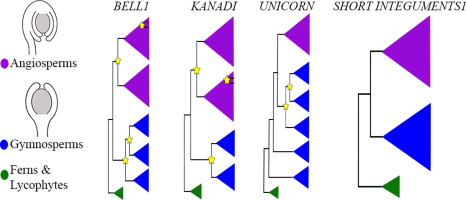当前位置:
X-MOL 学术
›
Mol. Phylogenet. Evol.
›
论文详情
Our official English website, www.x-mol.net, welcomes your feedback! (Note: you will need to create a separate account there.)
Phylogenetic analyses of key developmental genes provide insight into the complex evolution of seeds.
Molecular Phylogenetics and Evolution ( IF 4.1 ) Pub Date : 2020-03-09 , DOI: 10.1016/j.ympev.2020.106778 Cecilia Zumajo-Cardona 1 , Barbara A Ambrose 2
Molecular Phylogenetics and Evolution ( IF 4.1 ) Pub Date : 2020-03-09 , DOI: 10.1016/j.ympev.2020.106778 Cecilia Zumajo-Cardona 1 , Barbara A Ambrose 2
Affiliation

|
Gene duplication plays a decisive role in organismal diversification and in the appearance of novel structures. In plants the megagametophyte covered by the integuments, which after fertilization becomes the seed constitutes a novel structure: the ovule. In Arabidopsis thaliana, genetic mechanisms regulating ovule development, including the genetics underlying ovule initiation, ovule patterning and integument development, have been identified. Among seed plants, integuments are not only a novelty in evolution, but integuments also present an enormous morphological variation. This study is focused on the evolution of gene families that play a role in the proper morphological development of the integuments, BELL1 (BEL1), KANADIs (KAN1, KAN2, and KAN4/ATS), UNICORN (UCN) and SHORT INTEGUMENTS1 (SIN1). In Arabidopsis, BEL1 establishes the initiation of integument development. KAN1 and 2 act in the proper development of the outer integument. While ABERRANT TESTA SHAPE (ATS), is involved in the correct separation of both integuments. UCN acts in planar growth of the outer integument repressing ATS. SIN1 is involved in cell elongation in the integuments. The results of our analyses show that each of these genes has a different evolutionary history and that while gymnosperms appear to have a simpler ovule morphology, they have more homologues of these candidate genes than angiosperms. In addition, we present the conserved and novel motifs for each of these genes among seed plants and their selection constraints, which may be related to functional changes and to the diversity of ovule morphologies.
中文翻译:

关键发育基因的系统发育分析提供了对种子复杂进化的深入了解。
基因复制在生物多样性和新型结构的出现中起决定性作用。在植物中,被配子覆盖的巨型配子体在受精后成为种子,构成了一个新颖的结构:胚珠。在拟南芥中,已经确定了调节胚珠发育的遗传机制,包括胚珠起始,胚珠模式和皮被发育的遗传学。在种子植物中,被膜不仅是进化中的新奇事物,而且被膜还呈现出巨大的形态变异。这项研究的重点是基因家族的进化,这些基因家族在外皮,BELL1(BEL1),KANADIs(KAN1,KAN2和KAN4 / ATS),UNICORN(UCN)和SHORT INTEGUMENTS1(SIN1)的正确形态发育中起作用。在拟南芥中 BEL1建立了外皮开发的启动。KAN1和2在外被膜的适当发育中起作用。而ABERRANT TESTA SHAPE(ATS)涉及正确地分离两个外皮。UCN在抑制ATS的外被膜平面生长中起作用。SIN1与被膜的细胞伸长有关。我们的分析结果表明,每个基因都有不同的进化史,而裸子植物似乎具有更简单的胚珠形态,但与被子植物相比,它们具有更多的这些候选基因同源物。此外,我们提出了种子植物中这些基因中每个基因的保守和新颖基序及其选择限制,这可能与功能变化和胚珠形态的多样性有关。KAN1和2在外被膜的适当发育中起作用。而ABERRANT TESTA SHAPE(ATS)涉及正确地分离两个外皮。UCN在抑制ATS的外被膜平面生长中起作用。SIN1与被膜的细胞伸长有关。我们的分析结果表明,每个基因都有不同的进化史,而裸子植物似乎具有更简单的胚珠形态,但与被子植物相比,它们具有更多的这些候选基因同源物。此外,我们提出了种子植物中这些基因中每个基因的保守和新颖基序及其选择限制,这可能与功能变化和胚珠形态的多样性有关。KAN1和2在外皮的适当发育中起作用。而ABERRANT TESTA SHAPE(ATS)涉及正确地分离两个外皮。UCN在抑制ATS的外被膜平面生长中起作用。SIN1与被膜的细胞伸长有关。我们的分析结果表明,每个基因都有不同的进化史,而裸子植物似乎具有更简单的胚珠形态,但与被子植物相比,它们具有更多的这些候选基因同源物。此外,我们提出了种子植物中这些基因中每个基因的保守和新颖基序及其选择限制,这可能与功能变化和胚珠形态的多样性有关。UCN在抑制ATS的外被膜平面生长中起作用。SIN1与被膜的细胞伸长有关。我们的分析结果表明,每个基因都有不同的进化史,而裸子植物似乎具有更简单的胚珠形态,但与被子植物相比,它们具有更多的这些候选基因同源物。此外,我们提出了种子植物中这些基因中每个基因的保守和新颖基序及其选择限制,这可能与功能变化和胚珠形态的多样性有关。UCN在抑制ATS的外被膜平面生长中起作用。SIN1与被膜的细胞伸长有关。我们的分析结果表明,每个基因都有不同的进化史,而裸子植物似乎具有更简单的胚珠形态,但与被子植物相比,它们具有更多的这些候选基因同源物。此外,我们提出了种子植物中这些基因中每个基因的保守和新颖基序及其选择限制,这可能与功能变化和胚珠形态的多样性有关。它们比被子植物具有更多的这些候选基因的同源物。此外,我们提出了种子植物中这些基因中每个基因的保守和新颖基序及其选择限制,这可能与功能变化和胚珠形态的多样性有关。它们比被子植物具有更多的这些候选基因的同源物。此外,我们提出了种子植物中这些基因中每个基因的保守和新颖基序及其选择限制,这可能与功能变化和胚珠形态的多样性有关。
更新日期:2020-03-09
中文翻译:

关键发育基因的系统发育分析提供了对种子复杂进化的深入了解。
基因复制在生物多样性和新型结构的出现中起决定性作用。在植物中,被配子覆盖的巨型配子体在受精后成为种子,构成了一个新颖的结构:胚珠。在拟南芥中,已经确定了调节胚珠发育的遗传机制,包括胚珠起始,胚珠模式和皮被发育的遗传学。在种子植物中,被膜不仅是进化中的新奇事物,而且被膜还呈现出巨大的形态变异。这项研究的重点是基因家族的进化,这些基因家族在外皮,BELL1(BEL1),KANADIs(KAN1,KAN2和KAN4 / ATS),UNICORN(UCN)和SHORT INTEGUMENTS1(SIN1)的正确形态发育中起作用。在拟南芥中 BEL1建立了外皮开发的启动。KAN1和2在外被膜的适当发育中起作用。而ABERRANT TESTA SHAPE(ATS)涉及正确地分离两个外皮。UCN在抑制ATS的外被膜平面生长中起作用。SIN1与被膜的细胞伸长有关。我们的分析结果表明,每个基因都有不同的进化史,而裸子植物似乎具有更简单的胚珠形态,但与被子植物相比,它们具有更多的这些候选基因同源物。此外,我们提出了种子植物中这些基因中每个基因的保守和新颖基序及其选择限制,这可能与功能变化和胚珠形态的多样性有关。KAN1和2在外被膜的适当发育中起作用。而ABERRANT TESTA SHAPE(ATS)涉及正确地分离两个外皮。UCN在抑制ATS的外被膜平面生长中起作用。SIN1与被膜的细胞伸长有关。我们的分析结果表明,每个基因都有不同的进化史,而裸子植物似乎具有更简单的胚珠形态,但与被子植物相比,它们具有更多的这些候选基因同源物。此外,我们提出了种子植物中这些基因中每个基因的保守和新颖基序及其选择限制,这可能与功能变化和胚珠形态的多样性有关。KAN1和2在外皮的适当发育中起作用。而ABERRANT TESTA SHAPE(ATS)涉及正确地分离两个外皮。UCN在抑制ATS的外被膜平面生长中起作用。SIN1与被膜的细胞伸长有关。我们的分析结果表明,每个基因都有不同的进化史,而裸子植物似乎具有更简单的胚珠形态,但与被子植物相比,它们具有更多的这些候选基因同源物。此外,我们提出了种子植物中这些基因中每个基因的保守和新颖基序及其选择限制,这可能与功能变化和胚珠形态的多样性有关。UCN在抑制ATS的外被膜平面生长中起作用。SIN1与被膜的细胞伸长有关。我们的分析结果表明,每个基因都有不同的进化史,而裸子植物似乎具有更简单的胚珠形态,但与被子植物相比,它们具有更多的这些候选基因同源物。此外,我们提出了种子植物中这些基因中每个基因的保守和新颖基序及其选择限制,这可能与功能变化和胚珠形态的多样性有关。UCN在抑制ATS的外被膜平面生长中起作用。SIN1与被膜的细胞伸长有关。我们的分析结果表明,每个基因都有不同的进化史,而裸子植物似乎具有更简单的胚珠形态,但与被子植物相比,它们具有更多的这些候选基因同源物。此外,我们提出了种子植物中这些基因中每个基因的保守和新颖基序及其选择限制,这可能与功能变化和胚珠形态的多样性有关。它们比被子植物具有更多的这些候选基因的同源物。此外,我们提出了种子植物中这些基因中每个基因的保守和新颖基序及其选择限制,这可能与功能变化和胚珠形态的多样性有关。它们比被子植物具有更多的这些候选基因的同源物。此外,我们提出了种子植物中这些基因中每个基因的保守和新颖基序及其选择限制,这可能与功能变化和胚珠形态的多样性有关。



























 京公网安备 11010802027423号
京公网安备 11010802027423号